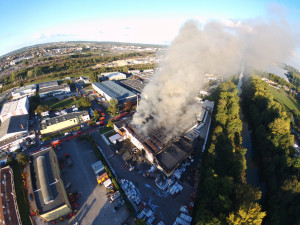At around 2:00 p.m., a fire broke out in a 4500 m² building used to store PVC products at a plant that produces plastic components for the building and sanitation sectors. Workers alerted emergency services. Firefighters arrived and fought the blaze using a mixture of water and additive. A huge plume of smoke rose into the sky and could be seen from more than 10 km away. A cordon was set up. Schools pupils were kept inside. Air samples did not reveal the presence of toxic agents in the smoke. Two employees, one sickened by the smoke and the other whose wrist was injured, were taken to hospital. A portion of the firewater contaminated soon after the firefighters arrived was discharged to the River Marne, killing the aquatic life. Downstream water intake stations were shut off. Firefighters blocked the stormwater outlet and deployed containment booms. The firewater was analysed and then transferred to the nearby wastewater treatment plant. Many hot spots still remained the following day. The cordon and containment measures were lifted at around 12:00 p.m. The fire was extinguished at 4:30 p.m.
The damage to the building and inventories of finished products amounted to €2 million. The rebuilding cost was estimated at €8 million. A specialised firm recovered the equipment and electronic data. The operator offered to reassign the plant’s 32 employees to other sites in the group. The fire started on a stack of pallets placed high up. It may have been caused by waterproofing work being done on the roof.
The inspection authorities for classified facilities visited the site and observed the following:
- The volume of PVC stored in the building (3680 m³) exceeds the legal limit (171 m³).
- The distance separating the building from the site’s property lines is 8 m, but as there is no 2-hour fire-rated wall or automatic fire suppression system, it should be at least 15 m.
- Materials stored outside should be kept at least 5 m away from the walls of the buildings. This is not the case.
- The operator was unable to provide the hot-work permit and/or the permit authorising the work to waterproof the roof.
- The operator failed to take the immediate necessary steps to contain the firewater and prevent it polluting the river.
In view of the substances released during the fire and the risk of the Marne being polluted by leachate from the waste on the site, the prefect issued an emergency-measures order on 29 September. The operator has three weeks to submit an analysis of the fire’s environmental impacts, one month to dispose of the waste, and six weeks to submit an analysis of the soil pollution.
The ensuing legal investigation resulted in the indictment of the contractor in charge of the roof work. He had failed to declare the two workers sent out to work on the roof.




